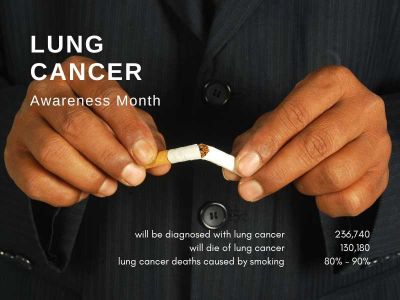Nov 17th, 2022
November is Lung Cancer Awareness Month and a time to stand together against the leading cause of cancer deaths among both men and women in the United States (CDC).
Lung cancer is the uncontrolled growth of abnormal cells in one or both of the lungs. There are two main forms of lung cancer: small cell lung cancer and non-small cell lung cancer. Non-small cell lung cancer is the more common form of the disease.
"236,740 patients will be diagnosed with lung and bronchus cancer and 130,180 patients will die of the disease in the United States in 2022"
-National Cancer Institute’s Surveillance, Epidemiology, and End Results (SEER)
There are several natural body changes that happen as you get older that may cause a decline in lung capacity. Muscles like the diaphragm can get weaker. Lung tissue that helps keep your airways open can lose elasticity, which means your airways can get a little smaller. Also your rib cage bones can change and get smaller which leaves less room for your lungs to expand. To learn more about how lungs work and its changes with aging, click here.
A decrease in lung function is a normal part of the aging process but it's important to be aware of the risks and symptoms involved in lung cancer. If you notice any sudden difficulties in breathing or shortness of breath, talk to your doctor right away.
Our Community
The American Lung Association's "State of Lung Cancer" report explores how lung cancer varies by state. It does this by analyzing key lung cancer indicators including incidence, survival, stage at diagnosis, surgical treatment, lack of treatment and screening rates. This is where Missouri stands:
Note: the 2023 State of Lung Cancer report will be available November 14, 2023.
- Rate of New Cases: our rate of new lung cancer cases is 70 and significantly higher than the national rate of 57
- Surgical Treatment: we ranked below average with 18% of cases undergoing surgery (first course of treatment) which is significantly lower than the national rate of 21%
- Prevention: our smoking rate is 18% and significantly higher than the national rate of 14%
- Disparities: while more Black Americans had early diagnosis than White Americans, they had less surgical treatment and more lack of treatment; Latino Americans in MO are least likely to be diagnosed early
Missouri falls into the top tier for percent of patients receiving no treatment. Some patients do refuse treatment, but issues such as fatalism and stigma can prevent eligible patients from accessing treatment that may save or extend their lives. All patients should work with their doctors to establish a treatment plan and goals.
Risks & Symptoms
Smoking is the most common cause of lung cancer. In fact, it causes 80-90% of lung cancer deaths in the United States (CDC). Other risk factors include being:
- exposed to secondhand smoke
- having a family history of lung cancer
- being treated with radiation therapy to the breast or chest
- exposure to asbestos, chromium, nickel, arsenic, soot, or tar in the workplace
- exposure to radon
When smoking is combined with other risk factors, the risk of lung cancer is increased.
If lung cancer is caught before it spreads, the likelihood of surviving 5 years or more improves to 60 percent (based on early-state lung cancer stats).
Warning signs for lung cancer can vary widely. Some people have symptoms related to the lungs; others whose lung cancer has spread to other parts of the body (metastasized) have symptoms specific to that part of the body; others have general symptoms of not feeling well. Most people with lung cancer don’t have symptoms until the cancer is advanced. Lung cancer symptoms may include:
- Coughing that gets worse or doesn’t go away
- Chest pain
- Shortness of breath
- Wheezing
- Coughing up blood
- Feeling very tired all the time
- Weight loss with no known cause
Prevention
These are ways you can lower your risk of lung cancer:
- Don't smoke: the most important thing you can do to prevent lung cancer is to not start smoking, or to quit if you smoke. Visit smokefree.gov for help.
- Avoid secondhand smoke: this includes smoke from people's cigarettes, cigars, or pipes. Make your home and car smoke-free.
- Get your home tested for radon: radon is the second leading cause of lung cancer.
- Be careful at work: follow health and safety guidelines in the workplace to avoid exposure to carcinogens.
- If you're a smoker, get screened: recommended only for adults who have no symptoms but are at high risk. Take the Saved by The Scan quiz from the American Lung Association to see if you should get screened – it can save your life.
It's also generally important to minimize your exposure to outdoor air pollution, avoid respiratory infections that can damage the lungs, get regular medical check-ups, and exercise.
Your health is important! The Cape Girardeau County Public Health Center stands with you in spreading awareness of lung cancer and the things you can do to keep your lungs healthy.
Sources: American Association of Cancer Research (AACR), American Lung Association, Centers for Disease Control and Prevention (CDC)
Updated: 11/1/24

